Four goals have I
This must be Calculation Manager week. (Do you have themed technology weeks? No? You must have some semblance of a life. How I envy you.) Putting aside the sadness (or happiness) of my life, this week is Calculation Manager week because during this very same set of five days the following occurred:
- On Tuesday, I gave an ODTUG webinar on The Most Awesome Planning Calculation Manager Hack the World Has Ever Seen
- A while back (okay, not within the same week – give me some artistic license) a thread also n Network54 about the reusability of graphical versus Script objects
- I was asked if it really was true that Calc Mgr 11.1.2.3 Templates cannot accept parameters
Whew, all (mostly) in one five day period. Sometimes you choose Calc Mgr, sometimes Calc Mgr chooses you.
The Most Awesome Planning Calculation Manager Hack the World Has Ever Seeen
I’ve written, presented, and generally bored the ears off of any number of unfortunates who happen to be near me when I start talking about the benefits of Focused Aggregations. Focused Aggregations is my term for using Planning and Hyperion Business Rules/Calculation Manager (actually, this is totally transferable to Dodeca and calc Scripts as well) to figure out what is in the Planning form POV and Page dimensions and then only aggregating the bits of the hierarchy that are impacted by the changes on the form. This radically reduces the scope of the calculated blocks and hence improves performance, sometimes a lot.
What this approach, until this great hack was invented (not by yr. obdnt. srvnt. alas), did not do was interpret the dimensions on the rows and columns of the form. This necessitated an AGG of the sparse dimensions which kind of negated the whole point of Focused Aggregations – an AGG just aggregates everything in the specified dimensions. And there the collective EPM world was until Christian M. came up with the technique through trial, error, and sheer desperation. I would throw in a bit of inspired genius as well.
I blogged about it here in some depth and in this webinar go even deeper into the concepts behind Focused Aggregations and of course show how to do everything along with benchmark results. It is a hack, but it is a most glorious one. And you will note that this is a blog with “hack” in its title.
Go listen to the presentation (I think my presentation does add something to the explanation) if you wish, or simply download a pdf of the presentation here for a quick review. Your choice.
Converting graphical objects to Script
AP (I have no idea who AP is) was in a bit of a pickle – he had converted a Hyperion Business Rules (so 11.1.2.1 or before) Planning application, complete with HBR macros, to 11.1.2.2. In doing so, the HBR macros went from being Script based (BSO calc Script language) to graphical. The question was: How does one convert those graphical Templates (Templates being the Calc Mgr replacement for HBR macros) to Script?
Here’s an example of a Workforce Planning Template. You can see that there isn’t any conversion functionality. And while some people are proponents of graphical Calc Mgr business rules, I am just too steeped in writing code to switch, so my interest was piqued by AP’s question.
It’s pretty easy
After spending five minutes trying every which way I could think of to convert the Template from graphical to Script, it occurred to me that I had reviewed graphical code as BSO calc Script language by clicking on the Begin node of a rule and then selecting the Script tab in the properties pane.
Looking at the rules that come with Workforce, I can see that there’s a rule called “Add TBH Hourly” that contains the very same Template.
NB – I am doing this with a predefined rule, but you could easily create a your own rule and drag a Template into it to accomplish the same result.
If I open the rule up I see that graphical Template.
By clicking on the Script tab in the bottom properties pane, I get: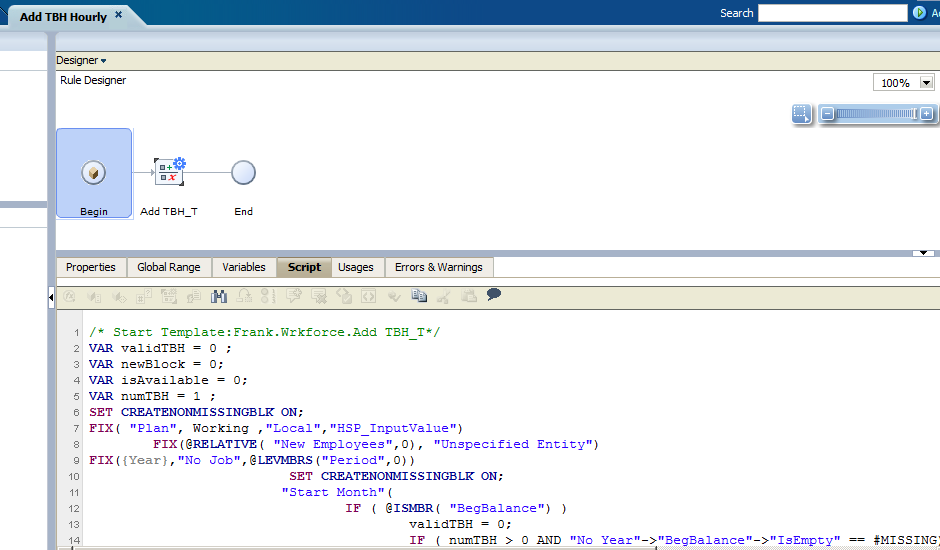
That code can be copied and pasted to a text editor. Once there, simply create a new Template and you are off to the races.
Here it is in Notepad++: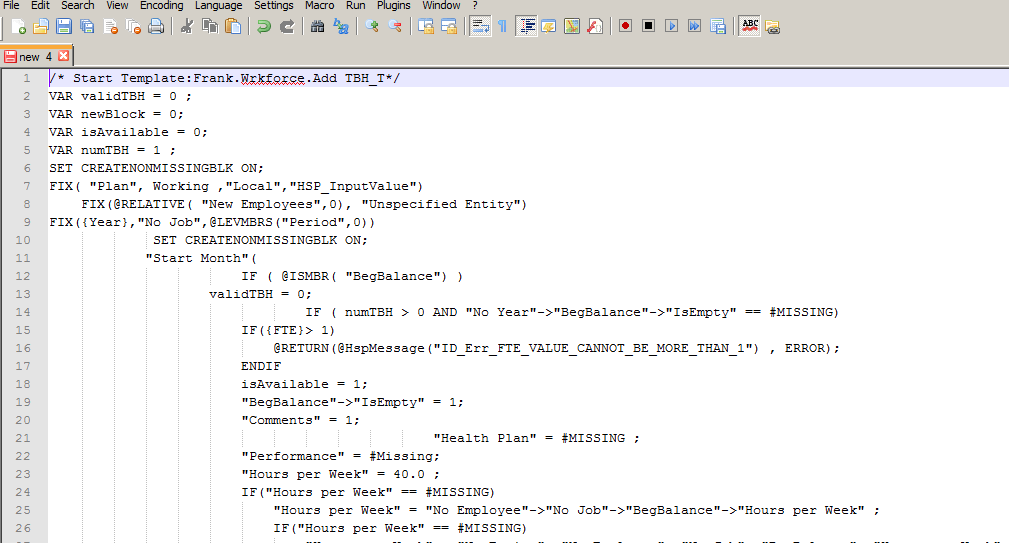
It’s a bit of a hack, but hey, remember, you are on a blog all about hacks. And it does get AP to where he wants to go.
Speaking of graphical versus Script
There was a thread a while back about a whole host of things about Calculation Manager over on Network54. (Technically this didn’t happen this week but now is a good time to review the thread.)
In the course of that thread, it was stated:
The bit that sort of surprised me was this statement:
“Yes. In fact, if you don't use it, you are probably missing out on one of the most powerful features of Calc Manager: reusable code objects.”
The “it” being Calc Mgr’s graphical interface and the implication being that you cannot reuse code unless it is graphical. Hmm, really? Perhaps I misunderstood.
And then that poster went on to write:
Okay, I didn’t misunderstand. Again he asserted, “To CL's point, I believe that when a developer converted the "graphical" Scripts to the other mode, we lost the reusability features and had to manually search-and-replace in those objects. And so, I have avoided it.”
Hmm, really? That bears testing out.
For the record, I am taking reusability features to mean – can a code based Script object be reused by reference and can a code based Template be reused by reference in Calc Mgr rules? That, to me, seems to be the essence of reusability. I think I know what specific reuse functions that commentator was referring to as “lost” and he isn’t the only one to think that. I will address that additional functionality later in this post. For the time being, let’s set the above baseline and prove or disprove it.
Test the first with Scripts
Here’s the simple code as a Script object:
Here’s a rule referring to a shared Script:
Here’s the deployed Script’s status after execution in Planning:
So that code-based Script works as a reusable object.
Test the second with Templates
The same simple code:
And now in a different rule:
Note the nice comment blocks that Calc Mgr gives us when we refer to a Template.
And here it is after successfully running in Planning: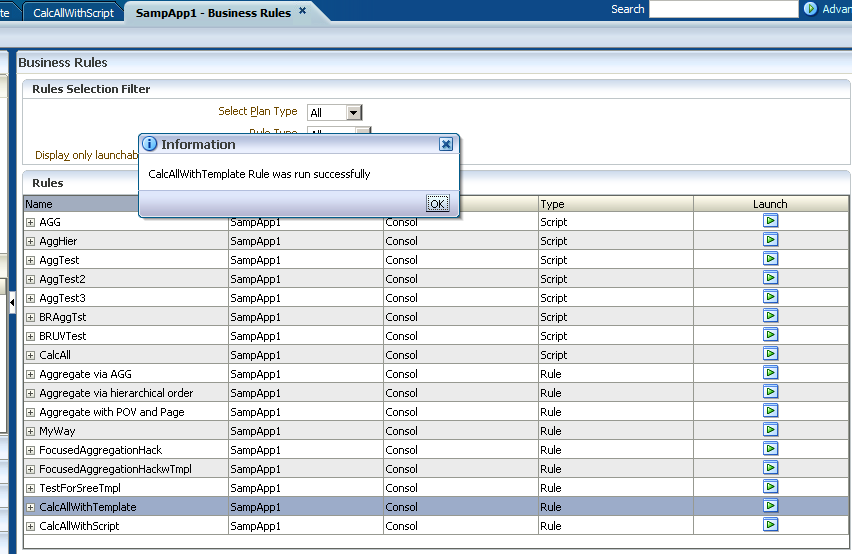
Conclusion
Code based objects, whether they be Scripts or Templates can be reused.
Yet another assertion that ain’t necessarily so
A former client of mine was converting an 11.1.2.0 Planning implementation to 11.1.2.3 via a consulting company That Shall Not Be Named. That company’s consultant got to one of my HBR macros with parameters and came up with a pretty interesting claim: In 11.1.2.3, Templates cannot receive parameters.
Huh? Really? That would be a huge reduction in functionality. I think it’s pretty safe to say that Oracle’s approach with the EPM products is not to reduce functionality, but to expand it. A lot. So I was rather surprised by this statement.
And it got more interesting because the consultant then went on to claim that he had checked with his company (I would actually do the same if I were he and of course if I had a company to fall back on) and they had confirmed this. Verrrrrrry interesting, if true. But that reduction in functionality just didn’t make sense.
So, in my Doubting Thomas persona (which is actually pretty close to way I view much of the world and is quite a useful one when it comes to IT), I went off to either prove or disprove this assertion. From such interactions are blog posts born.
A review of what Template parameters are and why you would care
Calc Mgr provides two different ways to share code as demonstrated above – through either Script or Template objects.
Given that the above example is functionally equivalent, it does sort of beg the question as to what Templates are for. After all, if a Script and a Template are the same, and a Script is easier to work with, why bother inventing Templates?
Just like HBR macros, Templates can be snippets of code or completely contained code streams.
Also, and here is what is crucial when you compare Scripts and Templates, Templates can be just simple code Scripts or huge combinations of Scripts, graphical objects, etc. Really anything you can create in an overall rule you can put into a Template. This is a huge jump in functionality over Scripts and of course (and this is one of the many things I like about Calc Mgr) it is completely up to you how you do this – have multiple discrete Templates and call them from a rule, have a huge Template that does all the logic, or have multiple discrete Templates that are managed by a calling Template that in turn is driven by a rule. Pretty cool, eh?
Again, just like HBR macros, Calc Mgr Templates (no matter how they are organized) can have parameters passed to the code stream that are then dynamically substituted on execution. This is a valuable bit of functionality because it allows us to write code as an object and then, as required, pass values to that bit of code. Please note that this is not the same as receiving the value of a Calc Mgr variable. That is also available to a Calc Mgr Template but those values are driven from Planning to Calc Mgr. What I am talking about is designer-specified values getting passed as required.
One use case might be custom currency conversion with multiple rates. Depending on how you write the code, you might want to pass different rates (actual, forecast, estimate, favorable, unfavorable, etc.) to the same base chunk of code. It’s the same code, just different rates (a specific member name) substituted in the code.
Of course you could rewrite the code multiple times and just repeat one code block after the other or you could create multiple Calc Mgr Scripts and use them as required but both techniques end up with way more code. In turn that larger code base will need to be maintained. Ouch.
If you could take that base bit of code and just substitute in the right rate you’d have a single point of maintenance. Less code that performs the same logic is A Good Thing. Unless you like maintaining redundant code in which case please stop reading this post.
Parameters, parameters, parameters
Assuming that you are lazy programmer, and hence a good one, let’s look at how Template parameters work.
But first a Template without a parameter.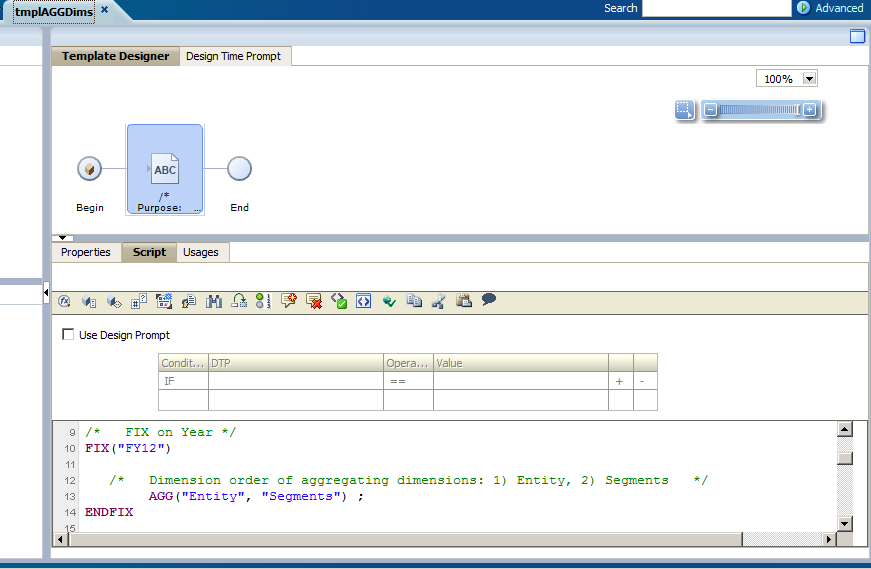
And its calling rule. Yes, this is silly. I am only showing this to set up the functionality.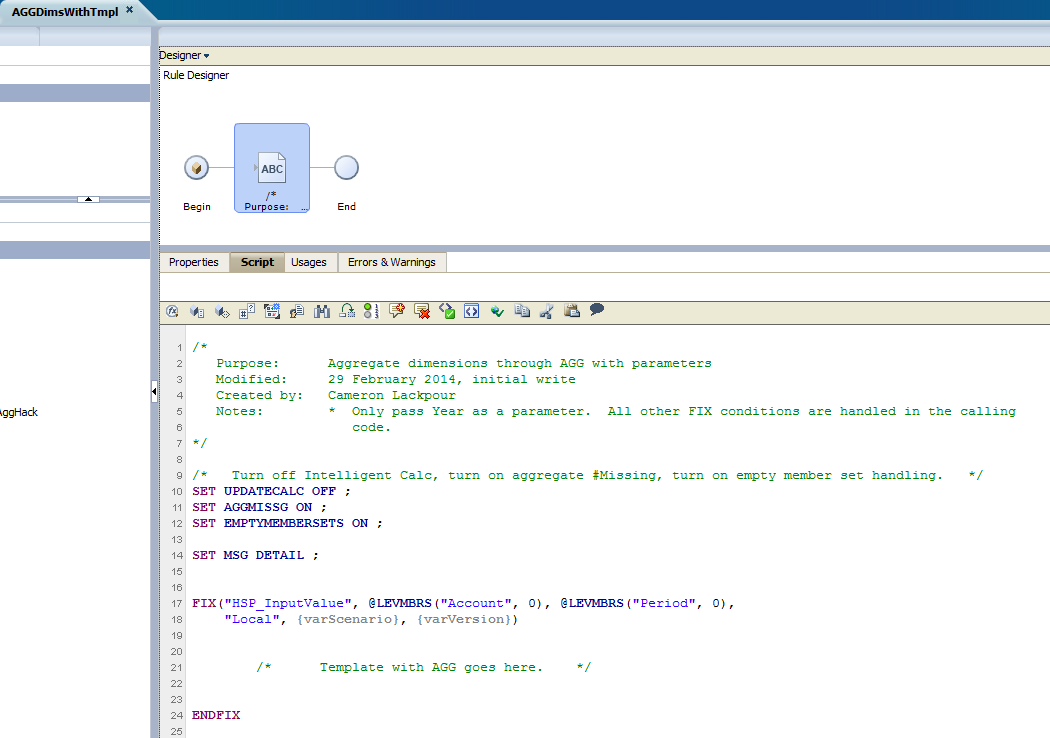
So what happens when I drag and drop the Template into the Script? I am going to show this in screenshots and also take a movie of it so you can see exactly what happens.
Here’s the drag: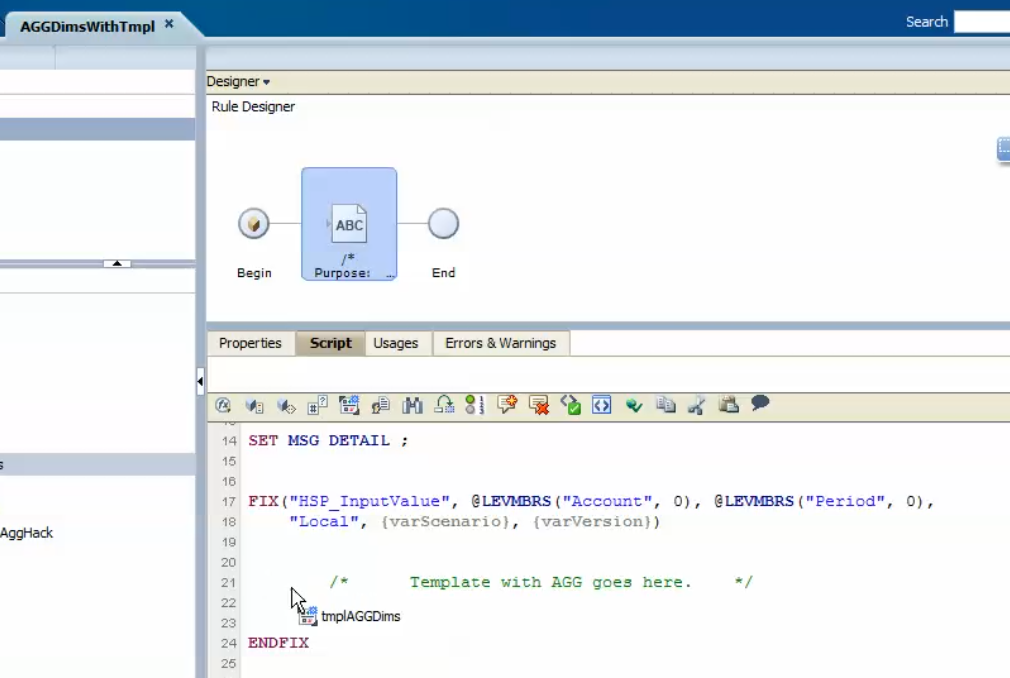
And the drop: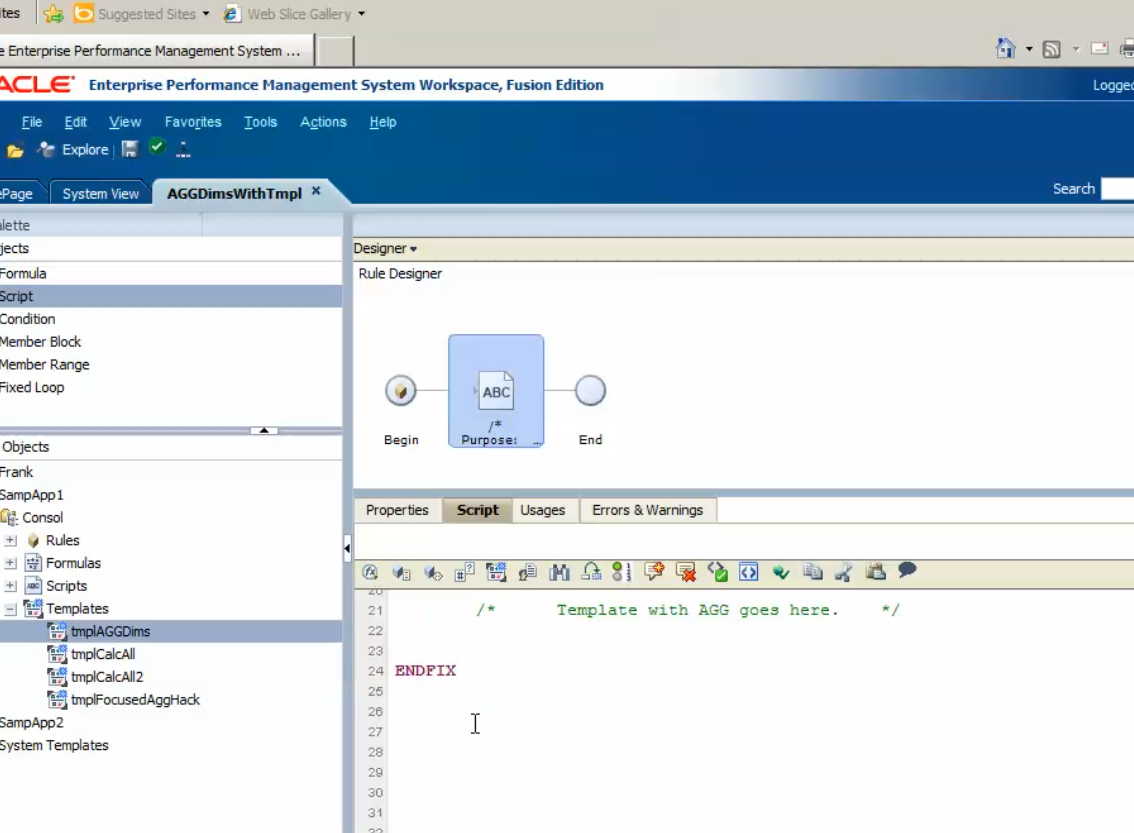
Huh? Where’s the Template? I dragged and dropped the Template into the Script and nothing showed up.
I think that is why both consultants said there was an issue with Script-based Templates. But I also think they are conflating a bug with a feature.
If this is unclear, go check out this movie. And yes, I’ve confirmed that this is a known defect to be fixed in 11.1.2.3.500.
Code reference
Did you know that Templates are referenced via code? It makes sense of course – our problem seems to be that a drag and drop does not result in that code. But if we knew the syntax, might we simply enter it? Referencing a Template code (without parameters) looks like this:
%Template(name:="Templatename",application:="appname",plantype="ptname",dtps:=())
Although you can actually get away with:
%Template(name:="Templatename")
Here it is in Calc Mgr just after validating:
So that’s one way around the issue of the drag and drop issue.
A Template with a parameter
So how do you reference, in code, a Template with a parameter?
It’s just an extension of the above example. Here’s the code for referencing a Template with a single parameter.
%Template(name:="Templatename",dtps:=("parametername":=[[parametervalue]]))
NB – Multiple parameters are comma delimited.
Defining a bad parameter
I am going to show you the wrong (or at least incomplete) way to do this so we can both experience the fairly awesome error message.
First I am going to insert a new row in the Design Time Prompt (DTP) tab of the Template.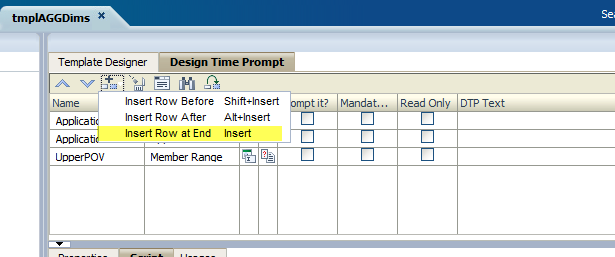
I’m going to give it a name of paramYear and select it as type member. Note the interesting other selections you can make for the type:
I am then going to replace the hardcoded “FY12” with paramYear. Just click on the insert variable toolbar button and then select the DTP you want:
Here it is in substituted into the code. Note the square brackets [] around the parameter. This is what normal variables looked like in HBR. Calc Mgr does this to differentiate between DTPs and Calc Mgr variables which have curly bracket {} symbols around the variable names.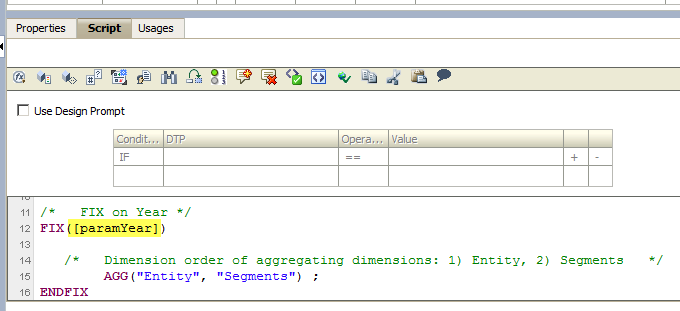
Now let’s go to our calling code, type in by hand the DTP settings, and see what happens:
What do we get when we try to do a validate: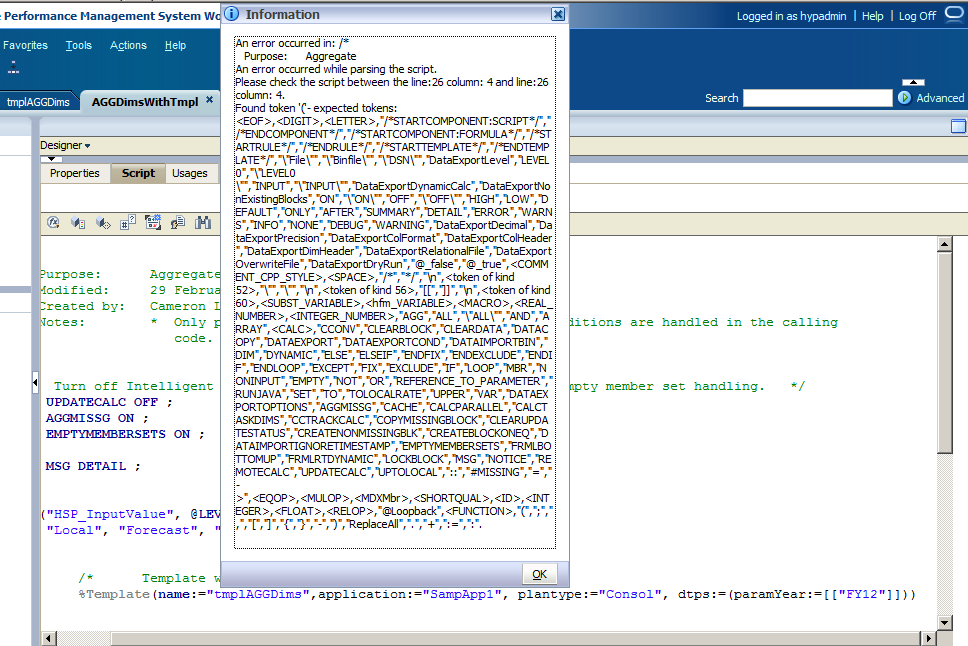
Unpossible! How did that not work? It is in fact syntactically correct, but we didn’t set the DTP correctly. This is going to be a little unintuitive, but bear with me.
Defining a parameter correctly
Let’s go back to the DTP definition.
First we need to make this promptable. Yes, it is weird that we have to set up a DTP with a prompt that in fact will never get prompted (it is set at design time, so what’s to prompt?) but again, just bear with me. 
NB – Optionally, you could select the Choose Dimension Limits to limt the scope of the RTP that shouldn’t ever need to be selected. 
Then click on the Template wizard. Within this wizard, you must create a step for the DTP to be executed. This isn’t totally intuitive, at least to me, but here’s my explanation of why this is important:
- The concept of a step only makes sense within the context of a promptable DTP. A promptable DTP itself only makes sense if you are passing a RTP variable into the Template. This is correct. The value could be a RTP variable from the rule or any text, member name or function.
- A step is analogous to a step in a wizard. When there is a prompt, the prompt has to cycle through steps to receive a value. If the calling code is passing a Calc Mgr variable (which is a RTP on its own) to the Templates DTP, that step is executed. Correct. Any promptable DTP that is part of a step that was skipped due to some condition will be set to blank at the end of the wizard completion.
I should mention that the text in black is my explanation, and the red text is from Sree Menon, the Oracle Calc Mgr product manager who very graciously responded to my questions. More about Sree down in the conclusion of the this (long) post.
In any case, you need to create a step, and then assign the paramter to that step. Think of it as a wizard that must be executed for the Template to run with parameters.
Click on the + symbol next to the Step dropdown:
Then give the step a name.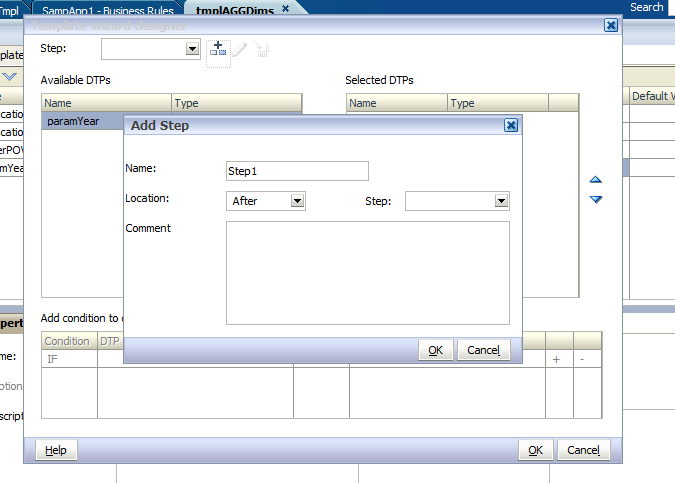
Then move the completed Step over to the Selected DTPs listbox:
Save the Template, and go back to your calling rule and validate:
Success! Boil in bag!
Now try dragging and dropping that Template into the rule (we’re going to calculate FY11 as well as FY12).
You’ll get a prompt for the value. Select type member:
Select FY11 and then click on Finish in the Step1 member selection dialog box: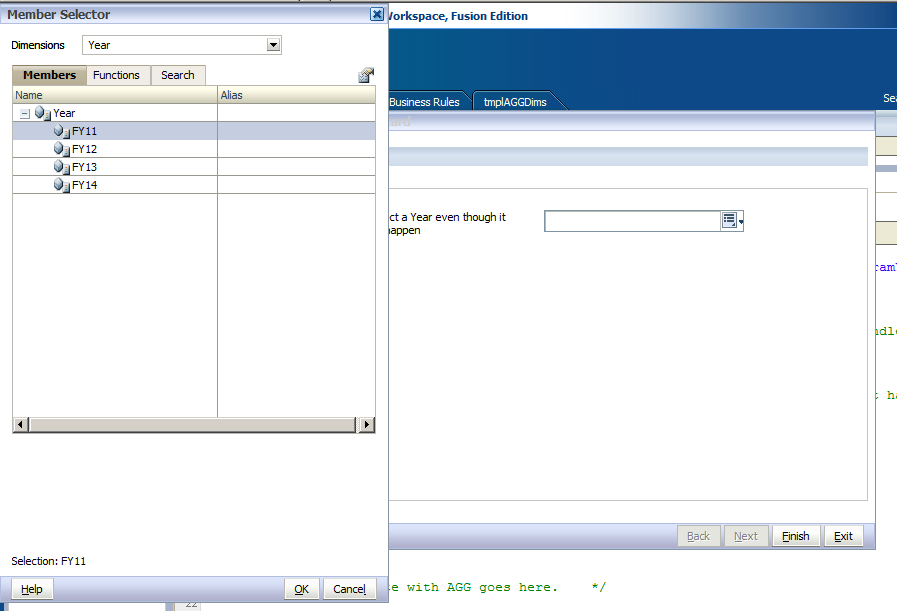
You now have a rule with a drag and drop defined code step for the Template tmplAGGDims.
Save, validate, and deploy the rule, and then go test it out in Planning: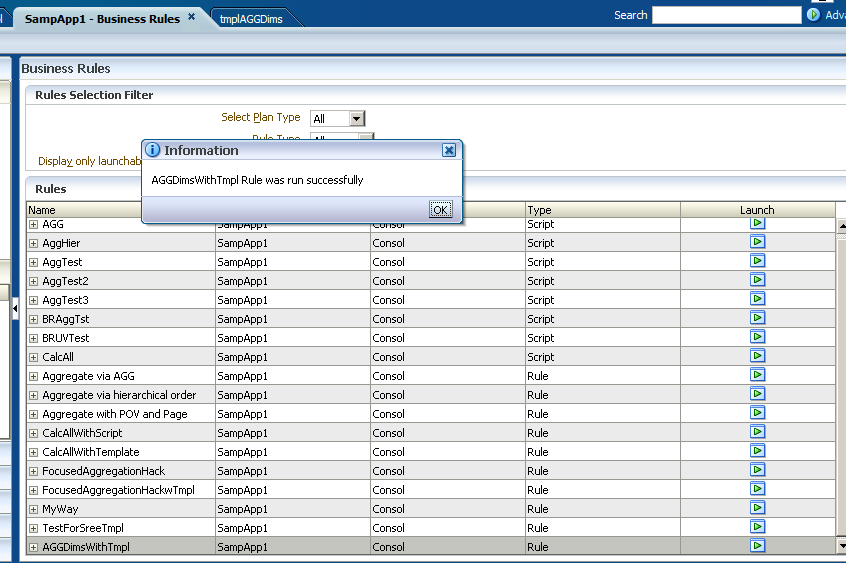
Ta da! You now have two parameter driven selections in a 11.1.2.3 Template! It is possible.
And what have we learnt?
A few interesting things:
- Calc Mgr can do all kinds of amazing things wrt Planning, including now finally squaring the circle on Planning rows and columns. This is only thanks to the generosity of the Oracle EPM community (Christian M and his coworkers). We own them a huge thanks because the inability to do this has hurt many Planning applications. In my opinion, this improved Focused Aggregation should be standard practice in all BSO Planning implementations.
- You can, if you wish, use Script or graphical objects in Calc Mgr and reuse them, or not, to your heart’s content. There is no restriction on reuse based on graphical versus Script status. None. To state otherwise is belied by what I demonstrated above.
- You can pass parameters to Templates in 11.1.2.3. If you don’t correctly define the DTP for the parameter, Calc Mgr doesn’t throw an error the way it should (I would rather have a “Yo! You forgot to set a step. Go back and sin no more.” kind of message than just blank lines. It appears that Oracle agrees given that this issue will be fixed.) but it does work. A little experimentation proves that.
- And that leads to the observation that there is opinion, and then there is fact. Sometimes the two match up; sometimes they do not. No matter what, opinion and fact are not the same thing. This blog most definitely has a voice, a point of view, and a large dose of my opinion. But it is also backed up with fact – I try to put myself in the shoes of a Doubting Thomas and then prove that what I say works. Sometimes I realize that I have been dead wrong. You never get to see those blog posts because they are memory holed. And when I am wrong and I don’t test enough and then publish it (I am thinking of that post where Jason Jones rather kindly corrected a pretty egregious mistake on my part) I dig right into that delicious dish of crow. I deserve it and while my ego is wounded my commitment to technical correctness doesn’t allow me any other path. Would it that all consultants thought the same way. :)
- Speaking of opinions, you shouldn’t believe everything you read on the internet. But you knew that, right? And if I were you, I wouldn’t believe anything yr. obdnt. srvnt. claims without fully testing it out on your side. Trust but verify is not a bad internet-as-a-source-of-wisdom approach.
One other observation: Sree Menon, the Calc Mgr product manager, suggested to me that I stick his Oracle email into this post and let world+dog beat a path to his Calc MGr door. I am quite familiar with the spam, phishing, and generally criminal nonsense that comes to this blog via its comments (and that you don’t see because I memory hole the lot), so I am not totally comfortable doing that.
What I propose instead is that if you have some burning question you want to ask Sree, please post it in the comments of this post, I will review it, contact you, and then if you pass the test (the test mostly being are you a human being asking for help or a spambot looking to make his life miserable) I will introduce the two of you. I am not Sree’s keeper but believe me when I tell you that this blog attracts weirdos (other than the weirdo writing all of this stuff) like iron filings to a magnet. In any case, the offer from Sree is geniune per our email conversation (again, me in black, Sree in red) below:
This definitely is blog material. Is it okay if I mention you? Not your email address, but just your name? Or would you prefer to remain anonymous? I have no issues in either giving my name or my oracle email. If people want to contact me directly using my email id, on one hand, I would love that. If I am able to help people, then I feel blessed.
Now that kind of response makes this particular geek get all misty eyed. Thanks again, Sree, for all of your input (and the input of your fellow product managers and developers). Thanks again!
Be seeing you.
10 comments:
I have a script that passes member names to a template and with the help of your blog, got it to work.
I have another script that passes run-time prompt variables as parameters to a template, but it refuses to validate (that error message rots). Below is one of the syntax variants that I've tried.
%Template(name:="P46",application:="FinAM",plantype:="FinAM",dtps:=("TMP_GEOG":=[[RTP_Geog]],"TMP_BU":=[[RTP_BU]],"TMP_PROD":=[[RTP_Prod]]))
I've tried a seemingly infinite combination of square brackets, curly brackets, double quotes, etc. I would like to take you up on your offer to invoke Sree's help. Thanks.
Thank you Cameron for your blog. This is very informative and I found it very useful for me.
For the anonymous poster:
I got this working:
%Template(name:="test",application:="PLN",plantype:="Plan1",dtps:=("YearParameter":=[[{GV_Year}]],"ScenarioParameter":=[["Forecast"]]))
%Template(name:="test",application:="PLN",plantype:="Plan1",dtps:=("YearParameter":=[["FY16"]],"ScenarioParameter":=[["Budget"]]))
Cameron,
Thanks for your help. I spent 7 hours working on the code yesterday to get this work and it works well. This example was very detailed and I it gave great information. Hyperion/Oracle seemed to make this more difficult then it needs to be.
Steve
Hi Cameron,
Is it possible use a @currmbr in a template, for example:
%Template(name:="PLT_DIST1",application:="MGAPP1",plantype:="Plan1", dtps:=("parm1":=@currmbr("Product")))
The parm is defined like Member, but it doesn't work.
Thanks
Hi Cameron,
Is it possible use a @currmbr in a template, for example:
%Template(name:="PLT_DIST1",application:="MGAPP1",plantype:="Plan1", dtps:=("parm1":=@currmbr("Product")))
The parm is defined like Member, but it doesn't work.
Thanks
Hi Cameron,
Is it possible use a @currmbr in a template, for example:
%Template(name:="PLT_DIST1",application:="MGAPP1",plantype:="Plan1", dtps:=("parm1":=@currmbr("Product")))
The parm is defined like Member, but it doesn't work.
Thanks
Thanks Brother Cameron. You are serving the world, and testifying about your faith at the same time!
FYI - it looks like your movie:
https://cameronl.opendrive.com/files?84420794_LTPg0
(and other files) are no longer on opendrive.
Hi Cameron,
Thank you for your blog, its very useful and informative.
Can we use template in between nested conditions.
I am using 4 different dates members in conditions, based on the condition i need to pass the two dates into templates.
Thanks
Hi Cameron,
Thank you for your blog, its very useful and informative.
Can we use template in between nested conditions.
I am using 4 different dates members in conditions, based on the condition i need to pass the two dates into templates.
Thanks
What are the hourly rate to upgrade the essbase? Does anyone have any info.
thanks
Post a Comment